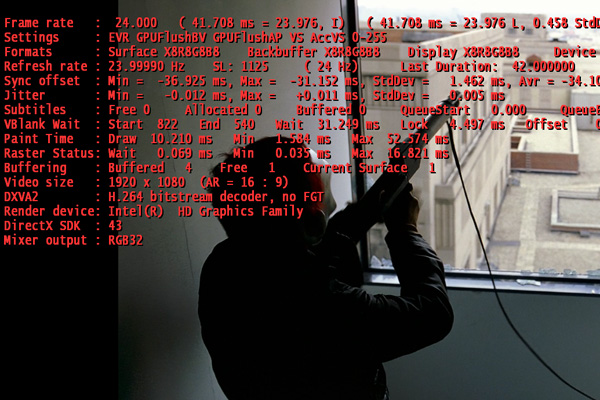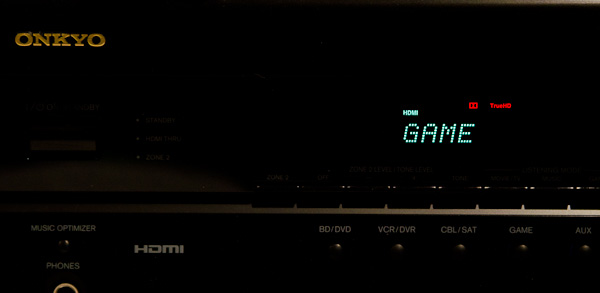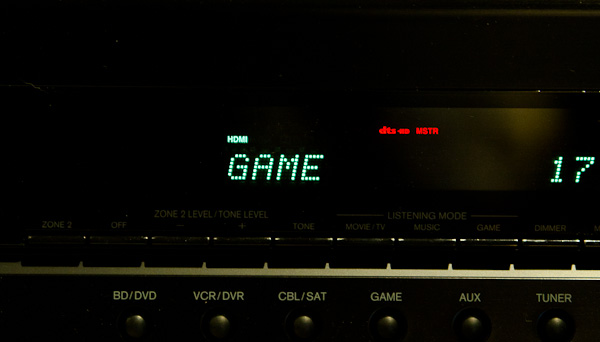The Sandy Bridge Review: Intel Core i7-2600K, i5-2500K and Core i3-2100 Tested
by Anand Lal Shimpi on January 3, 2011 12:01 AM ESTA Near-Perfect HTPC
Since 2006 Intel’s graphics cores have supported sending 8-channel LPCM audio over HDMI. In 2010 Intel enabled bitstreaming of up to eight channels of lossless audio typically found on Blu-ray discs via Dolby TrueHD and DTS-HD MA codecs. Intel’s HD Graphics 3000/2000 don’t add anything new in the way of audio or video codec support.
Dolby Digital, TrueHD (up to 7.1), DTS, DTS-HD MA (up to 7.1) can all be bitstreamed over HDMI. Decoded audio can also be sent over HDMI. From a video standpoint, H.264, VC-1 and MPEG-2 are all hardware accelerated. The new GPU enables HDMI 1.4 and Blu-ray 3D support. Let’s run down the list:
Dolby TrueHD Bitstreaming? Works:
DTS HD-MA bitstreaming? Yep:
Blu-ray 3D? Make that three:
How about 23.976 fps playback? Sorry guys, even raking in $11 billion a quarter doesn’t make you perfect.
Here’s the sitch, most movie content is stored at 23.976 fps but incorrectly referred to as 24p or 24 fps. That sub-30 fps frame rate is what makes movies look like, well, movies and not soap operas (this is also why interpolated 120Hz modes on TVs make movies look cheesey since they smooth out the 24 fps film effect). A smaller portion of content is actually mastered at 24.000 fps and is also referred to as 24p.
In order to smoothly playback either of these formats you need a player and a display device capable of supporting the frame rate. Many high-end TVs and projectors support this just fine, however on the playback side Intel only supports the less popular of the two: 24.000Hz.
This isn’t intentional, but rather a propagation of an oversight that started back with Clarkdale. Despite having great power consumption and feature characteristics, Clarkdale had one glaring issue that home theater enthusiasts discovered: despite having a 23Hz setting in the driver, Intel’s GPU would never output anything other than 24Hz to a display.
The limitation is entirely in hardware, particularly in what’s supported by the 5-series PCH (remember that display output is routed from the processor’s GPU to the video outputs via the PCH). One side effect of trying to maintain Intel’s aggressive tick-tock release cadence is there’s a lot of design reuse. While Sandy Bridge was a significant architectural redesign, the risk was mitigated by reusing much of the 5-series PCH design. As a result, the hardware limitation that prevented a 23.976Hz refresh rate made its way into the 6-series PCH before Intel discovered the root cause.
Intel had enough time to go in and fix the problem in the 6-series chipsets, however doing so would put the chipset schedule at risk given that fixing the problem requires a non-trivial amount of work to correct. Not wanting to introduce more risk into an already risky project (brand new out of order architecture, first on-die GPU, new GPU architecture, first integrated PLL), Intel chose to not address it this round, which is why we still have the problem today.

Note the frame rate
What happens when you try to play 23.976 fps content on a display that refreshes itself 24.000 times per second? You get a repeated frame approximately every 40 seconds to synchronize the source frame rate with the display frame rate. That repeated frame appears to your eyes as judder in motion, particularly evident in scenes involving a panning camera.
How big of an issue this is depends on the user. Some can just ignore the judder, others will attempt to smooth it out by setting their display to 60Hz, while others will be driven absolutely insane by it.
If you fall into the latter category, your only option for resolution is to buy a discrete graphics card. Currently AMD’s Radeon HD 5000 and 6000 series GPUs correctly output a 23.976Hz refresh rate if requested. These GPUs also support bitstreaming Dolby TrueHD and DTS-HD MA, while the 6000 series supports HDMI 1.4a and stereoscopic 3D. The same is true for NVIDIA’s GeForce GT 430, which happens to be a pretty decent discrete HTPC card.
Intel has committed to addressing the problem in the next major platform revision, which unfortunately seems to be Ivy Bridge in 2012. There is a short-term solution for HTPC users absolutely set on Sandy Bridge. Intel has a software workaround that enables 23.97Hz output. There’s still a frame rate mismatch at 23.97Hz, but it would be significantly reduced compared to the current 24.000Hz-only situation.
MPC-HC Compatibility Problems
Just a heads up. Media Player Classic Home Cinema doesn't currently play well with Sandy Bridge. Enabling DXVA acceleration in MPC-HC will cause stuttering and image quality issues during playback. It's an issue with MPC-HC and not properly detecting SNB as far as I know. Intel has reached out to the developer for a fix.














283 Comments
View All Comments
GeorgeH - Monday, January 3, 2011 - link
With the unlocked multipliers, the only substantive difference between the 2500K and the 2600K is hyperthreading. Looking at the benchmarks here, it appears that at equivalent clockspeeds the 2600K might actually perform worse on average than the 2500K, especially if gaming is a high priority.A short article running both the 2500K and the 2600K at equal speeds (say "stock" @3.4GHz and overclocked @4.4GHz) might be very interesting, especially as a possible point of comparison for AMD's SMT approach with Bulldozer.
Right now it looks like if you're not careful you could end up paying ~$100 more for a 2600K instead of a 2500K and end up with worse performance.
Gothmoth - Monday, January 3, 2011 - link
and what benchmarks you are speaking about?as anand wrote HT has no negative influence on performance.
GeorgeH - Monday, January 3, 2011 - link
The 2500K is faster in Crysis, Dragon Age, World of Warcraft and Starcraft II, despite being clocked slower than a 2600K. If it weren't for that clockspeed deficiency, it looks like it also might be faster in Left 4 Dead, Far Cry 2, and Dawn of War II. Just about the only game that looks like a "win" for HT is Civ5 and Fallout 3.The 2500K also wins the x264 HD 3.03 1st Pass benchmark, and comes pretty close to the 2600K in a few others, again despite a clockspeed deficiency.
Intel's new "no overclocking unless you get a K" policy looks like it might be a double-edged sword. Ignoring the IGP stuff, the only difference between a 2500K and a 2600K is HT; if you're spending extra for a K you're going to be overclocking, making the 2500K's base clockspeed deficiency irrelevant. That means HT's deficiencies won't be able to hide behind lower clockspeeds and locked multipliers (as with the i5-7xx and i7-8xx.)
In the past HT was a no-brainer; it might have hurt performance in some cases but it also came with higher clocks that compensated for HT's shortcomings. Now that Intel has cut enthusiasts down to two choices, HT isn't as clear cut, especially if those enthusiasts are gamers - and most of them are.
Shorel - Monday, January 3, 2011 - link
I don't ever watch soap operas (why somebody can enjoy such crap is beyond me) but I game a lot. All my free time is spent gaming.High frame rate reminds me of good video cards (or games that are not cutting edge) and the so called film 24p reminds me of the Michael Bay movies where stuff happens fast but you can't see anything, like in transformers.
Please don't assume that your readers know or enjoy soap operas. Standard TV is for old people and movies look amazing at 120hz when almost all you do is gaming.
mmcc575 - Monday, January 3, 2011 - link
Just want to say thanks for such a great opening article on desktop SNB. The VS2008 benchmark was also a welcome addition!SNB launch and CES together must mean a very busy time for you, but it would be great to get some clarification/more in depth articles on a couple of areas.
1. To clarify, if the LGA-2011 CPUs won't have an on-chip GPU, does this mean they will forego arguably the best feature in Quick Sync?
2. Would be great to have some more info on the Overclocking of both the CPU and GPU, such as the process, how far you got on stock voltage, the effect on Quick Sync and some OC'd CPU benchmarks.
3. A look at the PQ of the on-chip GPU when decoding video compared to discrete low-end rivals from nVidia and AMD, as it is likely that the main market for this will be those wanting to decode video as opposed to play games. If you're feeling generous, maybe a run through the HQV benchmark? :P
Thanks for reading, and congrats again for having the best launch-day content on the web.
ajp_anton - Monday, January 3, 2011 - link
In the Quantum of Solace comparison, x86 and Radeon screens are the same.I dug up a ~15Mbit 1080p clip with some action and transcoded it to 4Mbit 720p using x264. So entirely software-based. My i7 920 does 140fps, which isn't too far away from Quick Sync. I'd love to see some quality comparisons between x264 on fastest settings and QS.
ajp_anton - Monday, January 3, 2011 - link
Also, in the Dark Knight comparison, it looks like the Radeon used the wrong levels (so not the encoder's fault). You should recheck the settings used both in the encoder and when you took the screenshot.testmeplz - Monday, January 3, 2011 - link
Thanks for the great reveiw! I believe the colors in the legend of the graphs on the Graphics overclocking page are mixed up.THanks,
Chris
politbureau - Monday, January 3, 2011 - link
Very concise. Cheers.One thing I miss is clock-for-clock benchmarks to highlight the effect of architectural changes. Though not perhaps within the scope of this review, it would nonetheless be interesting to see how SNB fairs against Bloomfield and Lynnfield at similar clock speeds.
Cheerio
René André Poeltl - Monday, January 3, 2011 - link
Good performance for a bargain - that was amd's terrain.Now sandy bridge for ~200 $ targets on amd's clientel. A Core i5-2500K for $216 - that's a bargain. (included is even a 40$ value gpu) And the overclocking ability!
If I understood it correctly: Intel Core i7 2600K @ 4.4GHz 111W under load is quite efficient. At 3.4 ghz 86 W and a ~30% more 4.4 ghz = ~30% more performance ... that would mean it scales ~ 1:1 power consumption/performance.
Many people need more performance per core, but not more cores. At 111 W under load this would be the product they wanted. e.g. People who make music with pc's, not playing mp3's but mixing, producing music.
But for more cores the x6 Thuban is the better choice on a budget. For e.g. building a server on a budget intel has no product to rival it. Or developers - they may also want as many cores as they can get for their apps to test multithreading performance.
And Amd's also scores with their more conservative approach when it comes to upgrading e.g. motherboards. People don't like to buy a new motherboard every time they upgrade the cpu.